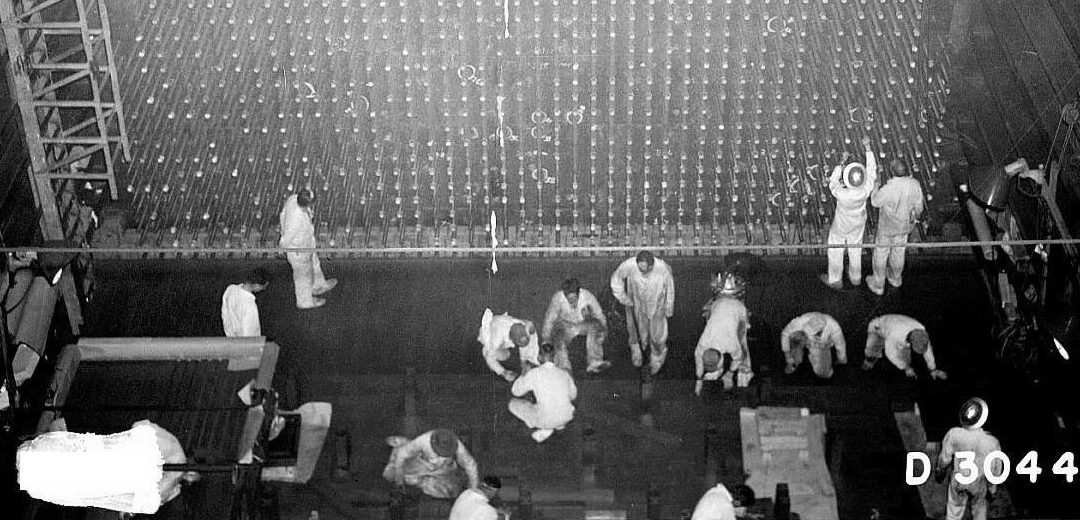—A fundamental objective of twentieth-century physics was to make subatomic particles go round and round increasingly faster—
One of the fundamental tools for research in the field of atomic and nuclear physics is the cyclotron. A cyclotron is a type of particle accelerator, of a circular trajectory, capable of imposing an increasingly fast spiral movement on charged subatomic particles, such as protons. The particles, which move in a vacuum following a curved path that results from the effect of a uniform magnetic field, are gradually accelerated from the high-frequency oscillations that generate an oscillating electric field. The development of the cyclotron was motivated, to a large extent, by the advantages that this type of accelerator presented over linear accelerators, since it allowed particles to be accelerated without the need to repeatedly use high voltages, until high-energy particles were obtained that could be used as projectiles to bombard atomic nuclei and study them. In this way, for example, radioisotopes could be produced, i.e., atoms with an unstable nucleus that emit radiation during their transition to a more stable shape.
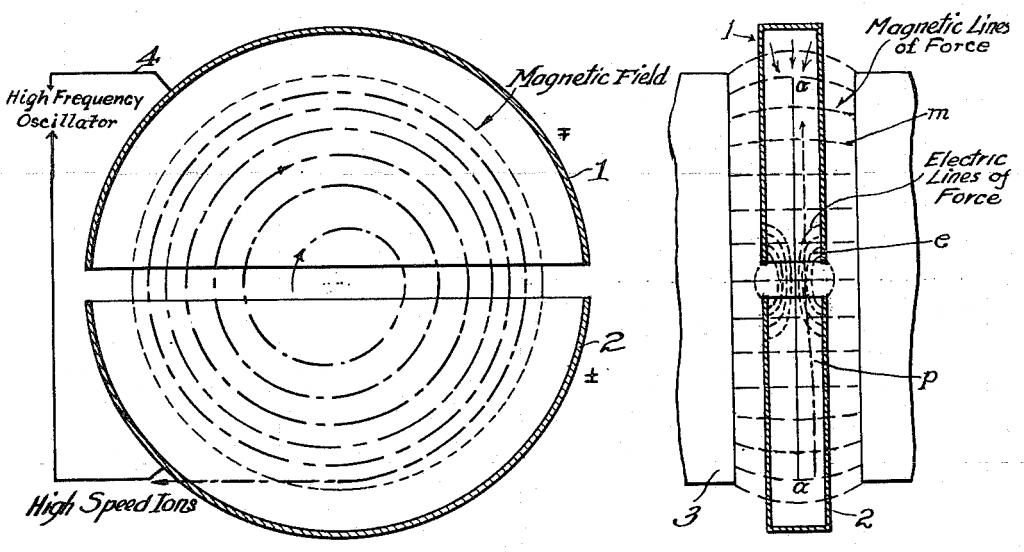
Cyclotron principles and design (Ernest Lawrence, 1934). Wikimedia.
The cyclotron was developed by the North Americans Ernest O. Lawrence (1901-1958) and M. Stanley Livingstone (1905-1986) in the early 1930s. Although it is true that similar initiatives designed to accelerate electrons already existed, such as the works of the Norwegian physicist Rolf Widerøe (1902-1996) or the patents presented by the Hungarian physicist Leo Szilard (1898-1964), it was Lawrence and Livingstone who succeeded in designing and building the first instrument of these characteristics capable of transferring sufficient energy to the particles to cause the disintegration of atomic nuclei. Convinced of the applications of this type of machine, Lawrence promoted the creation of a laboratory aimed at perfecting and improving the performance of the new instrument. This led to the creation of the Radiation Laboratory at the University of California at Berkeley (later, in the 1970s, renamed as the Lawrence Berkeley Laboratory, after its first director), a facility that was crucial to the subsequent success of the Manhattan Project. In fact, several authors have argued that the development of the cyclotron opened the door to what was later known as Big Science. It is not surprising that, during the 1930s, Lawrence and his team strove to achieve devices with increasing diameters to obtain particles capable of reaching higher and higher energy levels: from their first cyclotron of 69 cm in diameter, with which they achieved an energy of 4.8 MeV, to 152 cm in diameter, which generated an energy of 16 MeV. Its importance in the development of particle physics was such that it resulted in Lawrence being awarded the Nobel Prize in Physics in 1939.
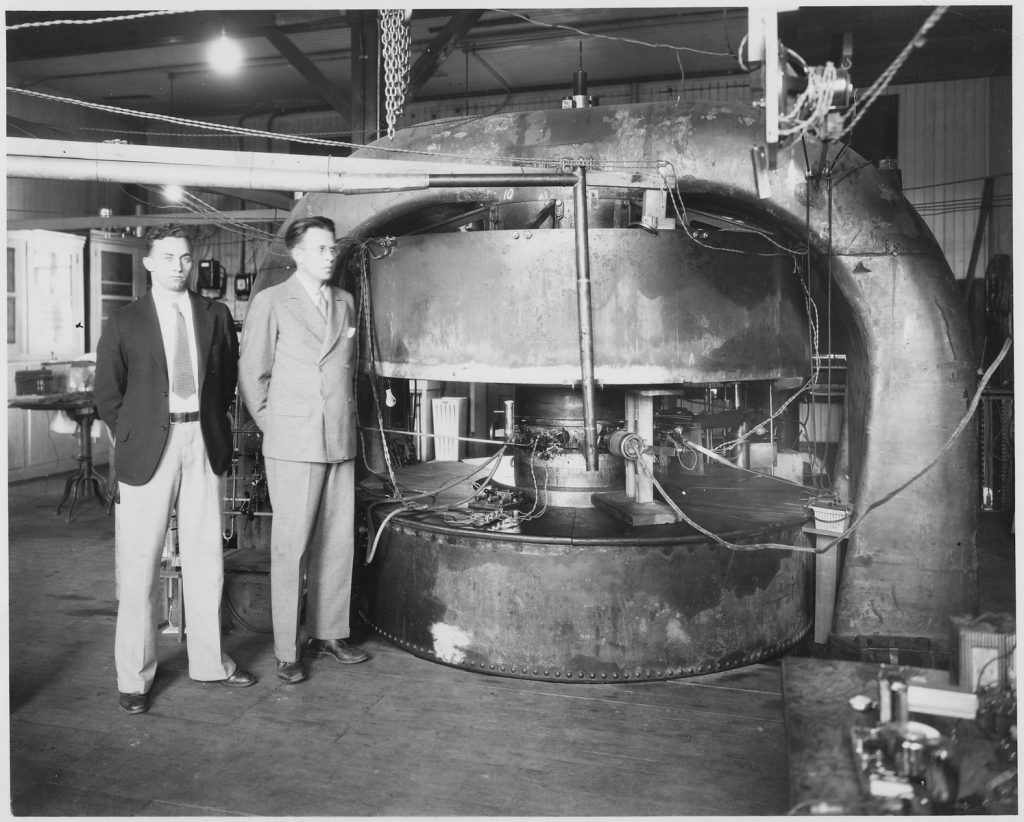
M. Stanley Livingston (left) and Ernest O. Lawrence (right) around 1934 next to the 69 cm (27 inch) diameter cyclotron in the former Radiation Laboratory at the University of California, Berkeley. Wikimedia.
From the outset, the possibility of using cyclotrons for medical purposes was explored. This was partly because potential medical applications increased the options for securing the necessary funding to further develop research. To this end, Ernest Lawrence convinced his brother John H. Lawrence (1904-1991), a qualified doctor, to use the 152 cm diameter cyclotron. The high-energy particles generated by this device could produce radioactive materials, radioisotopes, which they tried to use for therapeutic purposes. In fact, it is known that a phosphorus isotope (32P) was used to treat leukaemia patients, and the possibility of using neutrons to treat cancer and create markers for diagnosis was explored.
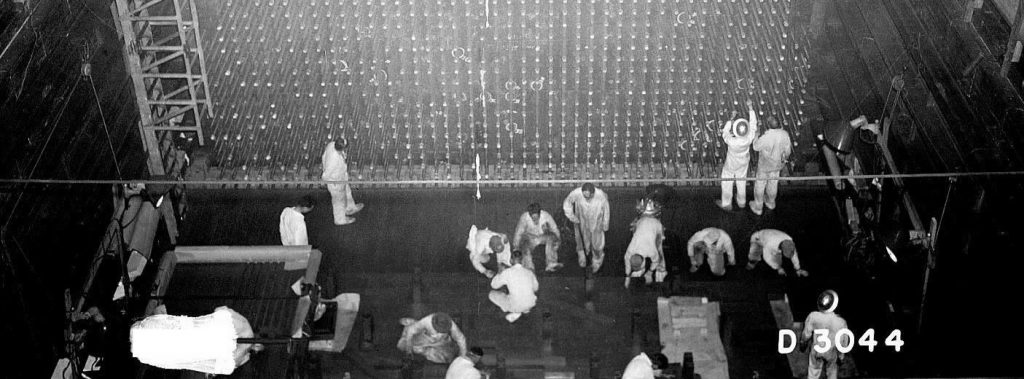
Construction of the Hanford B reactor (the first plutonium-producing reactor). Wikimedia.
These works were combined with the physical research carried out on cyclotrons, which led to the discovery of new chemical elements. It seems interesting to bring to light how, in the first stages of this research, not even the main protagonists of this story, such as Ernest Lawrence, dared to label the research they were developing. Was it nuclear physics? Nuclear chemistry? These types of issues are recurrent in different areas of scientific research in the early and mid-twentieth century, as also shown by X-ray crystallography or electron microscopy, areas of knowledge in which scientists from different backgrounds converged and which not only show the importance that interdisciplinary approaches to different issues were acquiring, but also the limits imposed by traditional scientific disciplines, which had to be renegotiated over time as a result of the consolidation of these new branches of knowledge.
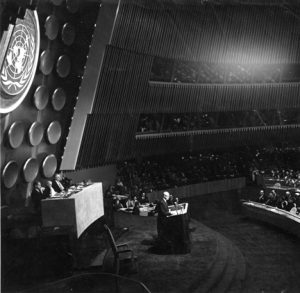
Address by US President Dwight D. Eisenhower to the United Nations General Assembly(1953). Eisenhower Presidential Library.
Research carried out with cyclotrons acquired special relevance during the Second World War, in particular from the work on the bombardment of uranium (238U) with deuterons, which generated neptunium nuclei (238Np) and in turn – through beta decay – plutonium nuclei (238Pu). The detection of this plutonium isotope meant, precisely, the discovery of this chemical element. This discovery was initially kept secret since it was a crucial element (especially 239Pu) for the production of nuclear weapons. At the same time, cyclotrons were also used as mass spectrometers to facilitate the separation of 235U and 238U isotopes and thus make progress in the possibility of building the much anticipated bombs.
The different uses of radioisotopes, especially their medical applications, remind us of some initiatives, such as the Atoms for Peace programme; a programme linked to the figure of the US President Dwight D. Eisenhower (1890–1969) and his famous speech to the United Nations General Assembly, in which he advocated the creation of an International Atomic Energy Agency. This body was conceived as an agency to provide aid, support and stability for civilian projects in peacetime based on atomic energy. Was it, however, a pacifist and humanitarian initiative? There was no doubt that nuclear energy made it possible to develop medical applications and that civilian uses, such as the possibility of establishing nuclear power plants, seemed to open a door to the development of countries most in need. Not to mention the multiple applications of radioactive isotopes in different branches of industry (from the oil and natural gas industries to the mining industry and applied metallurgy, through the textile, paper, glass and ceramics, food, pharmaceutical industries, etc.). However, as some authors have pointed out, it was rather a propaganda campaign to change the negative perception of nuclear energy that had been projected after the dropping of bombs on Hiroshima and Nagasaki, as well as a strategy to consolidate the predominance of the North American atomic industry in the world.
Pedro Ruiz-Castell
IILP-UV
How to cite this paper:
Ruiz-Castell, Pedro. The cyclotron. Sabers en acció, 2021-02-22. https://sabersenaccio.iec.cat/en/the-cyclotron/.
Find out more
You can find further information with the bibliography and available resources.
Recommended reading
Heilbron, John L.; Seidel, Robert W.; Wheaton, Bruce R. Lawrence and His Laboratory: Nuclear Science at Berkeley, 1931–1961. Berkeley: University of California Press; 1981.
Heilbron, John L.; Seidel, Robert W. Lawrence and His Laboratory: A History of the Lawrence Berkeley Laboratory, vol. 1. Berkeley: University of California Press; 1989.
Hiltzik, Michael. Big Science: Ernest Lawrence and the Invention that Launched the Military-Industrial Complex. New York: Simon & Schuster; 2015.
Studies
Alvarez, Luis. Ernest Orlando Lawrence, 1901–1958. Washington: National Academy of Science; 1970.
Childs, Herbert. An American Genius: The Life of Ernest Orlando Lawrence. New York: E. P. Dutton; 1968.
Creager, Angela N. H. Life Atomic: A History of Radioisotopes in Science and Medicine. Chicago: University of Chicago Press; 1992.
Creager, Angela N. H. Radioisotopes as political instruments, 1946–1953. Dynamis. 2009; 29: 219-239.
Krige, John. Atoms for peace, scientific internationalism, and scientific intelligence. Osiris. 2006; 21: 161-181.
Livingston, M. Stanley. The history of the cyclotron. In: Joho, W., ed. Proceedings of the 7th International Conference on Cyclotrons and their Applications Experientia Supplementum, vol. 24. Basel: Birkhäuser; 1975, p. 635-636.
Primary sources
Eisenhower, Dwight D. Atoms for Peace [Accessed 06/07/2017]. Available here.
Eisenhower, Dwight D. Draft of Presidential Speech Before the General Assembly of the United Nations. 28 November 1953. [Accessed 10/07/2020]. Available here.
Lawrence, Ernest O.; Livingston, M. Stanley. The Production of High Speed Light Ions Without the Use of High Voltages. Physical Review. 1932; 40: 19-35. Available here.
Lawrence, Ernest O. Patent US1948384 – Method and apparatus for the acceleration of ions. [Date of application 26 January 1932]. Available here.
Plata, A.; del Val Cob, M.; Gamboa, J. M. Aplicaciones de los isótopos radiactivos en la industria. Junta de Energía Nuclear: Madrid; 1962. Available here.
Websites and other sources
American Institute of Physics. Lawrence and the Cyclotron. [Accessed 6 July 2017]. Available here.
Bethe, Hans. Stanley Livingston’s small cyclotron. [Accessed 6/07/2017]. Available here.
Hicks, Jesse. Atoms for Peace: The Mixed Legacy of Eisenhower’s Nuclear Gambit. Distillations (Chemical Heritage Foundation); 2014. [Accessed 6/07/2017]. Available here.
Olsen, Christopher. A brief historical review of the invention of the cyclotron [Accessed 6/07/2017]. Available here.
Shiraishi, Satomi. Invention of Cyclotron. [Updated 16/04/2008]. Available here.
Yarris, Lynn. Ernest Lawrence’s Cyclotron: Invention for the Ages. [Accessed 6/07/2017]. Available here.

